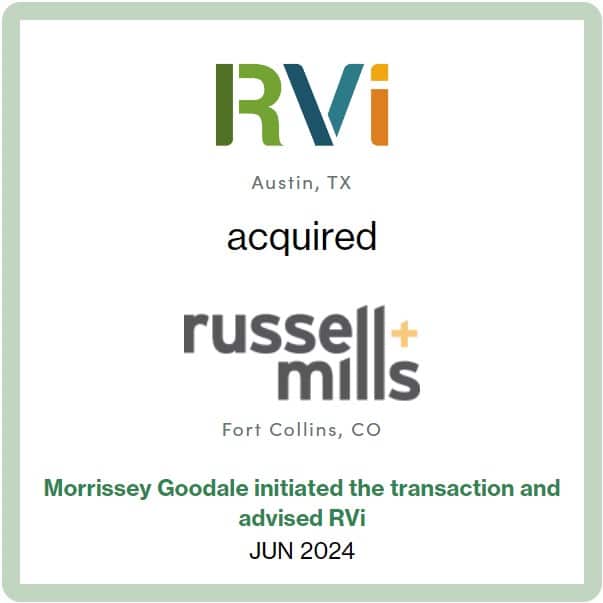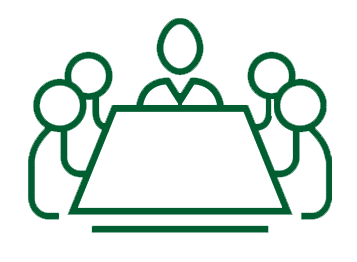Word on the street > 10 Things I’ve Learned About CEOs; What AI Deployment Could Look Like in Your Firm (Part 1)
Word on the Street: Issue 202
Weekly real-time market and industry intelligence from Morrissey Goodale firm leaders.

10 Things I’ve Learned About CEOs
Here are 10 things I’ve learned about industry CEOs since I started consulting to the industry in 1994. (Feel free to fight me on any of these.)
1. One-in-ten: Some of the best CEOs I’ve seen in action have two X chromosomes and/or are not originally design or environmental professionals. And by “best,” I mean—(a) have intentionally delivered upper-quartile, enterprise-wide performance consistently for over a decade, (b) have done this through good times and bad, and (c) have positioned the firm for a successful transition of their roles. Just 10% of industry CEOs are women, and only 11% of CEOs come to the position with a primary non-design or environmental degree (such as business or law).
2. Imposter syndrome is real: Unfortunately, many CEOs are in over their heads. They don’t have the vision, or the operational savvy, or curiosity or self-awareness, or confidence, or humility to truly lead. Most of their “business learning” has been on the job—with the one company at which they have spent most of their career. CEOs have been with their current firms on average around 27 years. These CEOs frequently suffer from various degrees of self-doubt—which they either mask through a variety of learned behaviors or bury deep, deep down. Unfortunately, most are unable or unwilling to ask for help. This cohort ages….fast.
3. Their support systems are weak: The competency and commitment chasm between the CEO and the rest of their executive team is Grand Canyon-like in its scale. While CEOs assume that their direct reports “get it” and are all rowing in the same direction, most actually don’t—and never will—“get it” and are instead covertly focused on protecting/managing their own turf/bonus potential. Many CEOs are living out, to some degree, each chapter of The Five Dysfunctions of a Team.
4. Governance is weaker: I want to be clear on this one. It’s far too easy, and really a cheap shot, to beat up on boards of directors as being too chummy, too old, too stuck in their ways, too eager to perpetuate the status quo, and too reliant on trying to replicate what they did at their own firms decades before to effectively improve things for the CEO. That’s it; that’s the bullet point.
5. They stick around too long: This applies primarily to the CEOs of employee-owned/ESOP firms. Whether it’s a founder or second- or third-generation CEO, they are preternaturally disposed to stick around and muddy decision-making for everyone else way beyond their sell-by date. For founders, this is because…well, they’re founders, and you can’t tell them anything. For next-generation CEOs, it’s because by the time they get to become CEOs, they are already too late in their careers. The average age of the ENR 500 CEO has crept up over the last few years to 59.
6. They could benefit from some real accountability: This applies (once again) mostly to the CEOs of employee-owned/ESOP firms. Many of these sit on their own company boards. (Indeed, they are often the chairperson of same.) They are also shareholders in their firms. And they, for sure—whether they like it or not—are employees of their firms. (You’d be amazed how many CEOs post time to projects on their timesheets.) So many CEOs NEVER get an annual review (physician, heal thyself). Many get to set their own compensation. (“Hey, I was a top-quartile performer this year, for sure; bring on the moolah.”) Few, if any, get fired (and if they do, it’s always after the damage has been done).
7. The industry’s next supermodel: If a CEO is tall, good-looking, and charismatic, there’s a good chance their firm is “going to go through some things” in the future. These are the folks you wish realized that they had imposter syndrome and would go and seek help or retire early. Instead, they over-reference business books and spout nonsense about the future and how the firm will get there, while concurrently destroying brand value along the way and wasting valuable time. (Note the gender-neutral nature of this bullet.)
8. The best ones live the clichés: They actively listen. They surround themselves with talent that is smarter than themselves and will challenge them—both on their executive teams and their boards. They see clearly and take seriously their roles as external and internal brand ambassadors above and beyond all else.
9. They are often lonely: Leading a firm means making tough decisions that few can relate to. While their teams are busy working in the business, they’re navigating the complex terrain of business strategy, client relations, and organizational culture, often without a peer to share the burden (see bullet #2).
10. They are survivors: The cream of the crop perseveres by transforming chaos into opportunity. Whether it’s adapting to digital transformation, navigating economic uncertainties, or responding to a global pandemic, they keep the doors open and make a profit every month, no matter the disruption.
Comments and reactions? Keep them clean please, and email Mick Morrissey @ [email protected] or text him at 508.380.1868.
What AI Deployment Could Look Like in Your Firm (Part 1)
Artificial intelligence (AI) isn’t just knocking on the door of the AE industry—it’s kicking it in. Ready or not, like it or not, AI is here to revolutionize how AE firms operate, pushing the boundaries of what’s possible and leaving traditional methods in the dust. But integrating AI isn’t a walk in the park. It’s more of a thrill ride full of twists and turns, ups and downs. For those daring enough to embark on this journey, the rewards can be immense—but the challenges are real.
Picture this: A mid-sized architectural firm struggling to keep up with complex designs, a large engineering company plagued by project delays and cost overruns, or a small environmental consulting firm bogged down by slow data collection and analysis. These firms each faced unique hurdles but also saw golden opportunities in AI. Their journeys, though fictional, are steeped in real-world challenges and triumphs that could mirror your own.
Welcome to the tales of Tenacious Architects Group, Preeminent Precision Engineering, and EcoFirm Environmental Consulting. Over the next few weeks, we’ll look at how each of these firms took the AI plunge in different ways, navigating the rough seas of implementation, dealing with skepticism, and reaping the benefits—all while keeping an eye on the horizon for the next big wave.
In this mini-series, you’ll find a mix of ambition and pragmatism, innovation and caution, success and ongoing struggle. These aren’t fairy tales with happily-ever-afters, but real-world narratives showing how AI can transform organizations and the ongoing challenges it brings. Take a look at how these firms tackled their unique challenges with AI, what strategies they used, and what hurdles they still face. Let their experiences ignite your imagination and help you forge a path to your own AI success story.
The Scenario of Tenacious Architects Group
Tenacious Architects Group (TAG) is a mid-sized architectural firm with a proud history and a traditional approach to design. The firm has built its reputation on the back of traditional technologies, such as CADD software. Despite its solid standing, TAG found itself struggling to keep up with the increasing demand for more complex and customized designs. The firm was at a crossroads: either adapt to the new technological landscape or risk becoming obsolete.
Opportunities
The firm’s leadership, led by CEO Emma Thornton, identified opportunities in using AI for generative design. Generative design uses AI algorithms to create multiple iterations based on specific constraints and preferences, offering innovative solutions that traditional methods might miss. However, as you might suspect, the idea of integrating AI was met with mixed reactions within the company.
The Supporters and the Skeptics
Emma was a forward-thinking leader, eager to embrace AI to propel TAG into the future. She was supported by a few key players, including CTO Michael Lee and junior architect Sarah Martinez. Michael had always been a tech enthusiast and saw AI as a way to revolutionize the firm’s design process. Sarah, relatively new to the firm, was excited about the potential for AI to open new creative avenues.
On the other hand, there were notable skeptics within the firm. Senior architect David Brown, a 25-year veteran of the company, was resistant to change. He believed that the firm’s traditional methods were the cornerstone of their success. David was joined by project manager Linda Epps, who feared that AI would lead to job losses and undermine the human touch that defined their work.
AI Strategy
Despite the internal resistance, Emma decided to invest in generative design software. She chose to introduce it gradually, starting with a few pilot projects to gauge its effectiveness and train the staff. Emma’s strategy was to demonstrate the tangible benefits of AI while addressing the concerns of the skeptics.
The first pilot project was a mid-sized residential complex. Michael and Sarah were tasked with leading the AI integration. They used the generative design software to create multiple design iterations, each optimized for various constraints such as cost, materials, and sustainability. The AI-generated designs were innovative, with unique aesthetic elements that traditional methods might not have considered.
Initial Outcomes
The pilot project showed promising results. The design phase was completed 30% faster, and the clients were impressed with the innovative solutions. Emma showcased these results in a company-wide meeting, emphasizing that AI was not replacing human architects but augmenting their capabilities. However, the transition was not without challenges.
David remained unconvinced. He pointed out that the AI-generated designs, while innovative, sometimes lacked the nuanced understanding of context that human architects bring. Linda highlighted the steep learning curve and the initial disruption to workflows. Some junior staff members were overwhelmed by the new technology and needed extensive training.
Addressing the Challenges
To address these concerns, Emma implemented several measures. She organized a series of workshops and training sessions led by Michael and Sarah to help staff get comfortable with the new technology. Emma also ensured that there was a clear communication strategy to explain how AI would enhance, not replace, the architects’ work. She emphasized the importance of human oversight in the AI-driven design process.
Emma also took David’s feedback seriously. She encouraged a collaborative approach where AI-generated designs were reviewed and refined by senior architects to ensure they met the firm’s standards. This collaboration helped bridge the gap between traditional methods and AI-driven innovation.
Further Integration
Buoyed by the success of the pilot project, Emma expanded the use of generative design software to more projects. One significant project was a commercial complex in the heart of the city. This project posed complex challenges in terms of space optimization, sustainability, and aesthetics. The AI-driven approach allowed the team to explore a wide range of design possibilities quickly.
As the technology became more integrated, some of the initial resistance began to wane. David, initially a staunch skeptic, started to see the value in AI when he realized it allowed him to focus more on the creative aspects of design rather than the repetitive tasks. Linda also acknowledged that the AI-driven project management tools helped streamline workflows and reduce errors, leading to more efficient project completion. And they both started having dinner at reasonable hours, which was not lost on either of them.
Long-Term Implications
While the integration of AI at TAG has been largely successful, it is an ongoing journey. The firm continues to invest in training and upgrading its AI tools to stay ahead. They also face the challenge of maintaining a balance between AI-driven innovation and the traditional design values that have defined their brand.
Emma is aware that the firm must continuously adapt to the evolving technological landscape. The AI tools need regular updates, and the staff needs ongoing training to keep up with advancements. Additionally, the firm has to manage client perceptions and ensure they understand the value that AI brings to the table.
In next week’s installment, Preeminent Precision Engineering’s project management woes drive the firm’s CEO to consider AI despite stiff internal buffeting. In the meantime, text your AI strategy thoughts and questions to Mark Goodale at 508.254.3914 or email [email protected].
Market Snapshot: State Financials
State budgets have experienced healthy years since federal emergency funds were made available during the pandemic. As we head into the second half of 2024, states are still in overall good shape financially, but things may be getting a bit tighter going forward due to shrinking reserves. Most states are expected to have increases in general-fund revenue, but overall spending is set to decrease.
As it relates to capital spending, these are the 10 states with the highest growth rates since before the pandemic (2019 to 2023):
- Indiana
- South Carolina
- Tennessee*
- Missouri
- Kansas*
- Utah*
- California
- Michigan
- Maryland*
- Alaska*
* States where 2023 capital spending was 10% or more of total spending.
To learn more about market intelligence data and research services offered by Morrissey Goodale, schedule an intro call with Rafael Barbosa.
Weekly M&A Round Up

Congratulations to RVi Planning + Landscape Architecture (Austin, TX): The design firm that offers land planning, landscape architecture, and outdoor space design services acquired Russell + Mills Studios (Fort Collins, CO), a landscape architecture, urban design, and master planning services firm. We’re thankful that the RVi team trusted us to advise them on this transaction.
Additional domestic deals in PA, NJ, DC, and OR: Last week we reported new domestic deals in PA, NJ, DC, and OR. Globally, we reported six deals in Australia, the UK, Singapore, and Canada. You can check all of last week’s M&A news here.
October 16-18, 2024 Houston, TX
Texas and the South M&A and Business Symposium
Over two-plus information-packed days, come together to discuss strategy, innovation, and M&A trends while networking with AE industry executives.
Learn More
AI & Innovation
Tap Into the Power of AI for your Firm
We’re partnering with the AI experts at Thrivence to bring AI Education and Business Solutions to the AE and environmental consulting Industry. Introducing a powerful 90-minute, on-demand AI Masterclass designed and delivered by CEOs for CEOs.

Searching for an external Board member?
Our Board of Directors candidate database has over one hundred current and former CEOs, executives, business strategists, and experts from both inside and outside the AE and Environmental Consulting industry who are interested in serving on Boards. Contact Tim Pettepit via email or call him directly at (617) 982-3829 for pricing and access to the database.
Are you interested in serving on an AE firm Board of Directors?
We have numerous clients that are seeking qualified industry executives to serve on their boards. If you’re interested, please upload your resume here.
Subscribe to our Newsletters
Stay up-to-date in real-time.










